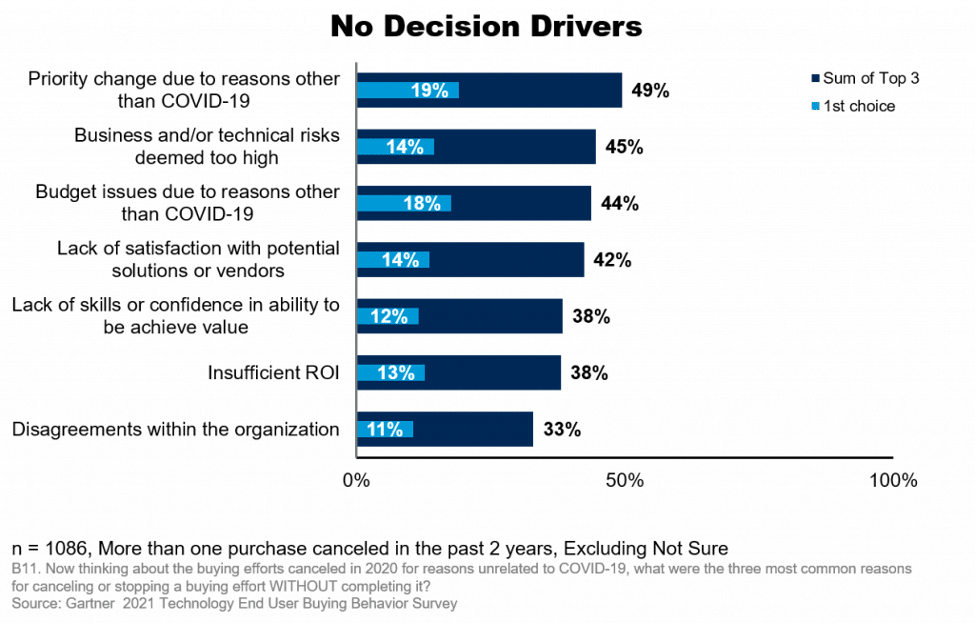
As we look at Sales performance, despite the current economic uncertainty, many sellers have more opportunities than ever in their pipeline, not less. However, more opportunities are surprisingly not leading to more closed deals and revenue growth.
Although more buyers than ever are willing to engage in exploring potential solutions and your proposal, many sellers are struggling to get their deals across the finish line. And the competition, although as fierce as ever, is not the biggest stumbling block.
The biggest risk to your opportunities and pipeline is a loss to “No Decision”, this according to Gartner research. A substantial 94% of B2B buyers surveyed have experienced a cancelled purchase cycle, and almost 40% of all the buying journeys end in “No Decision”.
The top drivers for “No Decision” should come as no surprise, and speak to the effects of Frugalnomics, where buyers are much more cautious, risk averse and economic-focused.
Surveying over 1,000 buyers who were involved in a cancelled purchase, the top three reasons for this include:
- Changes in priorities – 49%
- Perceived business and or technical risks – 45%
- Budget issues and constraints – 44%
From “No Decision” to “Yes”
As a seller, you need to be aware of the internal pressure on buyers and addressing their concerns proactively can get from “No Decision” to “Yes”.
Based on the top three priorities we suggest the following:
- Changes in Priorities – The first thing a seller can do to help overcome “No Decision” is to connect the proposal to solving priority organizational goals and objectives. Your presentations, proposal, statement of work, and business cases should all reiterate and reinforce the strategic goal and objective alignment.
Importantly, according to Gartner 53% of B2B buyers have reprioritized their spending across all categories, so it is vital to assure that the priorities have not changed underneath you, especially on along decision cycles and any opportunities that have been open for a while.
- Perceived business and or technical risks – Second, it is important to proactively address risks there may be in implementing, deploying or realizing the business outcomes in your solution. According to Gartner it is vital to “layout the changes needed to capture anticipated value. When prospects struggle to understand the potential value–and lack confidence in their ability to achieve it, your opportunity is at risk”.
To help overcome the perceived risk issue, you should not avoid but actually “embrace the risk” by discussing implementation, deployment, adoption and outcome realization risks up-front, assuring services to mitigate these risks and assure success, or even providing no risk guarantees. In concert, it is important not just to embrace but prove that for the risks are reasonable, sharing relevant success stories with evidence of risks avoided or transcended, and tangible business outcomes delivered.
- Budget issues and constraints – Finally, to advance deals beyond “No Decision”, you need to solidly communicate and quantify the high cost of the status quo and “do nothing” and the value anticipated from the proposed solution. These need to be documented in a solid, credible financial justification business case that the seller works on collaboratively with the prospect / customer.
Through the crisis, 38% have put in place a spending freeze according to Gartner, and almost all significant purchases now require executive / committee approval and substantial financial justification. Without motivating buyers to move away from a substantial pain via illuminating a high cost of “do nothing”, and a business case to document the return on investment (ROI) you won’t be able to convince the CF”No” and COVID committee to thaw the spending freeze and prioritize precious spending and resources towards your proposal.
The Bottom Line
Through the crises, most pipelines are loaded with more opportunities, but more opportunities have not equated to more wins.
According to Gartner, too many opportunities are ending in “No Decision”. And although this shouldn’t come as a big surprise, with buyers more risk averse, cautious and economic-focused than ever before, it isn’t a healthy situation – “no es bueno”.
In order to get “No Decision” to “Yes”, just like you would with selling against a competitor, a good seller strategically plans and positions to counter the alternative choice. Against each of the top 3 “No Decision” reasons, this includes the best sellers proactively:
- Addressing changes in priorities by assuring the solution aligns with the top priority, relevant priorities of the day
- Countering perceived business and or technical risks by being up-front about potential risks, structuring services, plans and programs to mitigate these risks and sharing success stories to show that proposed business outcomes are more than achievable.
- Overcoming budget issues and constraints with an illumination of “do nothing” costs and a solid business case, co-created with the prospect, that communicates and quantifies the personal, business and organizational value to be delivered.
Sources:
- No Decisions Should Rarely Be a Surprise – https://blogs.gartner.com/hank-barnes/2021/03/02/no-decisions-should-rarely-be-a-surprise/
- Gartner – The B2B Buying Journey https://www.gartner.com/en/sales-service/insights/b2b-buying-journey
- Challenger B2B Buyer Study – 2020/2021
#salesenablement #valueselling #valueacceleration #nodecision #garner #challenger

Comments are closed.